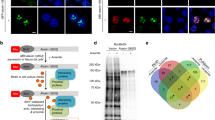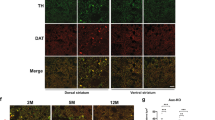Abstract
Instability of CAG DNA trinucleotide repeats is the mutational mechanism for several neurodegenerative diseases resulting in the expansion of a polyglutamine (polyQ) tract. Proteins with long polyQ tracts have an increased tendency to aggregate, often as truncated fragments forming ubiquitinated intranuclear inclusion bodies. We examined whether similar features define spinocerebellar ataxia type 2 (SCA2) pathogenesis using cultured cells, human brains and transgenic mouse lines. In SCA2 brains, we found cytoplasmic, but not nuclear, microaggregates. Mice expressing ataxin-2 with Q58 showed progressive functional deficits accompanied by loss of the Purkinje cell dendritic arbor and finally loss of Purkinje cells. Despite similar functional deficits and anatomical changes observed in ataxin-1[Q80] transgenic lines, ataxin-2[Q58] remained cytoplasmic without detectable ubiquitination.
This is a preview of subscription content, access via your institution
Access options
Subscribe to this journal
Receive 12 print issues and online access
$209.00 per year
only $17.42 per issue
Buy this article
- Purchase on Springer Link
- Instant access to full article PDF
Prices may be subject to local taxes which are calculated during checkout







Similar content being viewed by others
References
Orr, H.T. et al. Expansion of an unstable trinucleotide CAG repeat in spinocerebellar ataxia type 1. Nature Genet. 4, 221–226 (1993).
Kawaguchi, Y. et al. CAG expansions in a novel gene for Machado-Joseph disease at chromosome 14q32.1. Nature Genet 8, 221–228 (1994)
Zhuchenko, O. et al. Autosomal dominant cerebellar ataxia (SCA6) associated with small polyglutamine expansions in the α-1A-voltage-dependent calcium channel. Nature Genet. 15, 62–69 (1997).
David, G. et al. Cloning of the SCA7 gene reveals a highly unstable CAG repeat expansion. Nature Genet. 17, 65–70 (1997).
The Huntington's Disease Collaborative Research Group. A novel gene containing a trinucleotide repeat that is expanded and unstable on Huntington's disease chromosomes. Cell 72, 971–983 (1993).
La Spada, A.R, Wilson, E.M., Lubahn, D.B., Harding, A.E. & Fischbeck, K.H. Androgen receptor gene mutations in X-linked spinal and bulbar muscular atrophy. Nature 352, 77–79 (1991).
Koide, R. et al. Unstable expansion of CAG repeat in hereditary dentatorubral-pallidoluysian atrophy (DRPLA). Nature Genet. 6, 9–13 (1994).
Cummings, C.J. et al. Chaperone suppression of aggregation and altered subcellular proteasome localization imply protein misfolding in SCA1. Nature Genet. 19, 148–154 (1998).
Paulson, H.L. et al. Intranuclear inclusions of expanded polyglutamine protein in spinocerebellar ataxia type 3. Neuron 19, 333–344 (1997).
Trottier, Y. et al. Heterogeneous intracellular localization and expression of ataxin-3. Neurobiol. Dis. 5, 335–347 (1998).
Holmberg, M. et al. Spinocerebellar ataxia type 7 (SCA7): a neurodegenerative disorder with neuronal intranuclear inclusions. Hum. Mol. Genet. 7, 913–918 (1998).
Igarashi, S. et al. Suppression of aggregate formation and apoptosis by transglutaminase inhibitors in cells expressing truncated DRPLA protein with an expanded polyglutamine stretch. Nature Genet. 18, 111–117 (1998).
Davies, S.W. et al. Formation of neuronal intranuclear inclusions underlies the neurological dysfunction in mice transgenic for the HD mutation. Cell 90, 537–548 (1997).
Martindale, D. et al. Length of huntingtin and its polyglutamine tract influences localization and frequency of intracellular aggregates. Nature Genet. 18, 150–154 (1998).
Saudou, F., Finkbeiner, S., Devys, D. & Greenberg, M.E. Huntingtin acts in the nucleus to induce apoptosis but death does not correlate with the formation of intranuclear inclusions. Cell 95, 55–66 (1998).
Scherzinger, E. et al. Huntingtin-encoded polyglutamine expansions form amyloid-like protein aggregates in vitro and in vivo. Cell 90, 549–558 (1997).
Stenoien, D.L. et al. Polyglutamine-expanded androgen receptors form aggregates that sequester heat shock proteins, proteasome components and SRC-1, and are suppressed by the HDJ-2 chaperone. Hum. Mol. Genet. 8, 731–741 (1999).
Reddy, P.H. et al. Behavioural abnormalities and selective neuronal loss in HD transgenic mice expressing mutated full-length HD cDNA. Nature Genet. 20, 198–202 (1998).
Paulson, H.L. Protein fate in neurodegenerative proteinopathies: polyglutamine diseases join the (mis) fold. Am. J. Hum. Genet. 64, 339–345 (1999).
Gutekunst, C.A. et al. Nuclear and neuropil aggregates in Huntington's disease: relationship to neuropathology. J. Neurosci. 19, 2522–2534 (1999).
Kuemmerle, S. et al. Huntington aggregates may not predict neuronal death in Huntington's disease. Ann. Neurol. 46, 842–849 (1999).
Klement, I.A. et al. Ataxin-1 nuclear localization and aggregation: role in polyglutamine-induced disease in SCA1 transgenic mice. Cell 95, 41–53 (1998).
Cummings, C.J. et al. Mutation of the E6-AP ubiquitin ligase reduces nuclear inclusion frequency while accelerating polyglutamine-induced pathology in SCA1 mice. Neuron 24, 879–892 (1999).
Ishikawa, K. et al. Abundant expression and cytoplasmic aggregations of [α]1A voltage-dependent calcium channel protein associated with neurodegeneration in spinocerebellar ataxia type 6. Hum. Mol. Genet. 8, 1185–1193 (1999).
Nechiporuk, T. et al. The mouse SCA2 gene: cDNA sequence, alternative splicing, and protein expression. Hum. Mol. Genet. 7, 1301–1309 (1998).
Imbert, G. et al. Cloning of the gene for spinocerebellar ataxia 2 reveals a locus with high sensitivity to expanded CAG/glutamine repeats. Nature Genet. 14, 285–291 (1996).
Pulst, S.-M. et al. Moderate expansion of a normally biallelic trinucleotide repeat in spinocerebellar ataxia type 2. Nature Genet. 14, 269–276 (1996).
Sanpei, K. et al. Identification of the spinocerebellar ataxia type 2 gene using a direct identification of repeat expansion and cloning technique, DIRECT. Nature Genet. 14, 277–284 (1996).
Huynh, D.P., Del Bigio, M.R., Ho, D.H. & Pulst, S.-M. Expression of ataxin-2 in brains from normal individuals and patients with Alzheimer's disease and spinocerebellar ataxia 2. Ann. Neurol. 45, 232–241 (1999).
Koyano, S. et al. Neuronal intranuclear inclusions in spinocerebellar ataxia type 2: triple-labeling immunofluorescent study. Neurosci. Lett. 273, 117–120 (1999).
Ikeda, H. et al. Expanded polyglutamine in the Machado-Joseph disease protein induces cell death in vitro and in vivo. Nature Genet. 13, 196–202 (1996).
Mangiarini, L. et al. Exon 1 of the HD gene with an expanded CAG repeat is sufficient to cause a progressive neurological phenotype in transgenic mice. Cell 87, 493–506 (1996).
Mangiarini, L. et al. Instability of highly expanded CAG repeats in mice transgenic for the Huntington's disease mutation. Nature Genet. 15, 197–200 (1997).
Davies, S.W. et al. From neuronal inclusions to neurodegeneration: neuropathological investigation of a transgenic mouse model of Huntington's disease. Phil. Trans. R. Soc. Lond. B Biol. Sci. 354, 981–989 (1999).
Burright, E.N. et al. SCA1 transgenic mice: a model for neurodegeneration caused by an expanded CAG trinucleotide repeat. Cell 82, 937–948 (1995).
Clark, H.B. et al. Purkinje cell expression of a mutant allele of SCA1 in transgenic mice leads to disparate effects on motor behaviors, followed by a progressive cerebellar dysfunction and histological alterations. J. Neurosci. 17, 7385–7395 (1997).
Vandaele, S. et al. Purkinje cell protein-2 regulatory regions and transgene expression in cerebellar compartments. Genes Dev. 5, 1136–1148 (1991).
Paulson, H.L. et al. Intranuclear inclusions of expanded polyglutamine protein in spinocerebellar ataxia type 3. Neuron 19, 333–344 (1997).
Hodgson, J.G. et al. A YAC mouse model for Huntington's disease with full-length mutant huntingtin, cytoplasmic toxicity, and selectivity striatal neurodegeneration. Neuron 23, 181–192 (1999).
Sanchez, I. et al. Caspase-8 is required for cell death induced by expanded polyglutamine repeats. Neuron 22, 623–633 (1999).
Kim, M. et al. Mutant huntingtin expression in clonal striatal cells: dissociation of inclusion formation and neuronal survival by caspase inhibition. J. Neurosci. 19, 964–973 (1999).
Wellington, C.L. et al. Caspase cleavage of gene products associated with triplet expansion disorders generates truncated fragments containing the polyglutamine tract. J. Biol. Chem. 273, 9158–9167 (1998).
Vig, P.J. et al. Reduced immunoreactivity to calcium-binding proteins in Purkinje cells precedes onset of ataxia in spinocerebellar ataxia-1 transgenic mice. Neurology 50, 106–113 (1998).
Koeppen, A.H. The Purkinje cell and its afferents in human hereditary ataxia. J. Neuropathol. Exp. Neurol. 50, 505–514 (1991).
Chai, Y. et al. Evidence for proteasome involvement in polyglutamine disease: localization to nuclear inclusions in SCA3/MJD and suppression of polyglutamine aggregation in vitro. Hum. Mol. Genet. 8, 673–682 (1999).
Garcia-Mata, R. et al. Characterization and dynamics of aggresome formation by a cytosolic GFP-chimera. J. Cell Biol. 146, 1239–1254 (1999).
Johnston, J.A., Ward, C.L. & Kopito, R.R. Aggresomes: a cellular response to misfolded proteins. J. Cell Biol. 143, 1883–1898 (1998).
Shibata, H., Huynh, D.P. & Pulst S.-M. A novel protein with RNA binding motifs interacts with ataxin-2. Hum. Mol. Genet. 9, 130–1313 (2000).
Mezey, E. et al. α synuclein is present in Lewy bodies in sporadic Parkinson's disease. Mol. Psychiatry 3, 493–499 (1998).
Lippa, C.F. et al. Lewy bodies contain altered α-synuclein in brains of many familial Alzheimer's disease patients with mutations in presenilin and amyloid precursor protein genes. Am. J. Pathol. 153, 1365–1370 (1998).
Acknowledgements
We thank A. Koeppen and M. Del Bigio for tissue samples from SCA2 patients; H. Orr for the pZ03-β-Gal expression vector with the Pcp2 promoter; C. Readhead and M. Schibler for assistance with transgenic mouse lines and confocal microscopy, respectively; T. Ho, A. Schlesinger and M. Dy for technical support; and D. Scoles and T.-R. Kiehl for critically reading the manuscript. This work was supported by the Carmen and Louis Warschaw Endowment for Neurology, F.R.I.E.N.D.s of Neurology, the National Ataxia Foundation, grant RO1-NS33123 (SMP) and a Long Term Disabled Scientist Supplement (DPH) from the National Institutes of Health.
Author information
Authors and Affiliations
Corresponding author
Rights and permissions
About this article
Cite this article
Huynh, D., Figueroa, K., Hoang, N. et al. Nuclear localization or inclusion body formation of ataxin-2 are not necessary for SCA2 pathogenesis in mouse or human. Nat Genet 26, 44–50 (2000). https://doi.org/10.1038/79162
Received:
Accepted:
Issue Date:
DOI: https://doi.org/10.1038/79162
This article is cited by
-
A chlorzoxazone–folic acid combination improves cognitive affective decline in SCA2-58Q mice
Scientific Reports (2023)
-
Cognitive Decline and Mood Alterations in the Mouse Model of Spinocerebellar Ataxia Type 2
The Cerebellum (2023)
-
TR-FRET-Based Immunoassay to Measure Ataxin-2 as a Target Engagement Marker in Spinocerebellar Ataxia Type 2
Molecular Neurobiology (2023)
-
Consensus Paper: Strengths and Weaknesses of Animal Models of Spinocerebellar Ataxias and Their Clinical Implications
The Cerebellum (2022)
-
Autophagy in Spinocerebellar ataxia type 2, a dysregulated pathway, and a target for therapy
Cell Death & Disease (2021)



